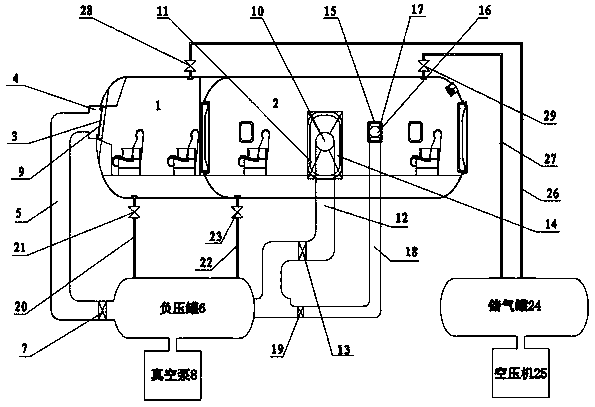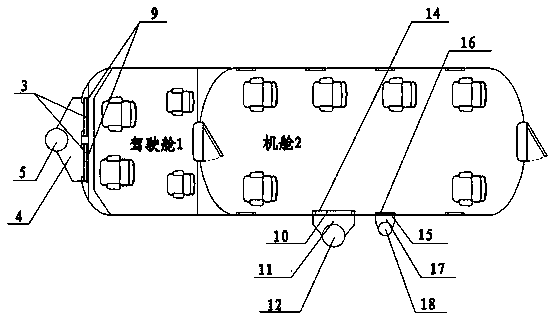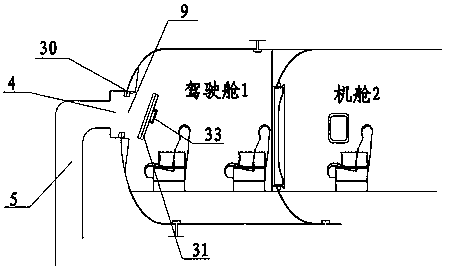Simulation rapid decompression chamber for civil aircraft
A technology for rapid decompression of civil aircraft, applied to simulators, simulation devices for space navigation conditions, instruments, etc.
- Summary
- Abstract
- Description
- Claims
- Application Information
AI Technical Summary
Problems solved by technology
Method used
Image
Examples
Embodiment 1
[0031] What this embodiment discloses is a simulated rapid decompression cabin of a civil cabin emptying device, and the cabin body includes a cockpit 1 and a cabin 2, and a simulated front window 3 is set in front of the cockpit 1, and the simulated front window 3 is divided into left and right sides. One, corresponding to the main driver's position and the co-pilot's position respectively, the size of the window can be adjusted according to the needs of simulation training of different models. The simulated front window is set on the cabin body, and the customized flange is processed and fixed on the cabin body by welding to form a window frame. The front window negative pressure cover 4 is connected and fixed on the outside of the window frame. The front window negative pressure cover 4 is a The window frame is dimensionally matched and has steel pressure-resistant connectors of a certain thickness. The back of the front window negative pressure cover 4 is connected with th...
Embodiment 2
[0039] The difference between this embodiment and Embodiment 1 is that, in addition to the front window variable adjustment device 9 being arranged on the simulated front window 3 of the cockpit 1, a door variable adjusting device 9 is also arranged on the hatch door of the cabin 2. Regulator 14.
[0040] Similar to the loss of confidentiality and loss of pressure that may occur in the cockpit 1, the aircraft may also cause loss of confidentiality and loss of pressure in the cabin 2 due to various reasons during flight, such as the failure of the cabin door resulting in air leakage from the cabin door or the overall failure of the cabin door. Falling off and flying out of the cabin and so on. In order to carry out adaptive training and emergency response drills to the flight attendants in the cabin 2, the simulated rapid decompression cabin of the present embodiment is provided with a simulation device for simulating cabin door loss of secrecy in the cabin 2 (as attached figu...
Embodiment 3
[0043] The difference between this embodiment and Embodiment 1 is that, in addition to the front window variable adjustment device 9 being arranged on the simulated front window 3 of the cockpit 1, the cabin door variable adjustment device 14 is arranged on the hatch of the cabin 2 In addition, the porthole variable adjustment device 16 is also configured on the porthole of the engine room 2 .
[0044] Similarly, in order to simulate the rapid decompression in the engine room caused by cracks and falling off of the portholes in the engine room 2, a simulated porthole 15 and a variable adjustment device 16 for the porthole are installed on the bulkhead of the engine room 2. The porthole negative pressure cover 17 and the porthole negative pressure pipeline 18 are connected to the negative pressure tank 6, and a porthole electric control gate valve 19 is installed on the porthole negative pressure pipeline 18, which simulates a rapid decompression in the cabin when the porthole i...
PUM
 Login to View More
Login to View More Abstract
Description
Claims
Application Information
 Login to View More
Login to View More - R&D
- Intellectual Property
- Life Sciences
- Materials
- Tech Scout
- Unparalleled Data Quality
- Higher Quality Content
- 60% Fewer Hallucinations
Browse by: Latest US Patents, China's latest patents, Technical Efficacy Thesaurus, Application Domain, Technology Topic, Popular Technical Reports.
© 2025 PatSnap. All rights reserved.Legal|Privacy policy|Modern Slavery Act Transparency Statement|Sitemap|About US| Contact US: help@patsnap.com



